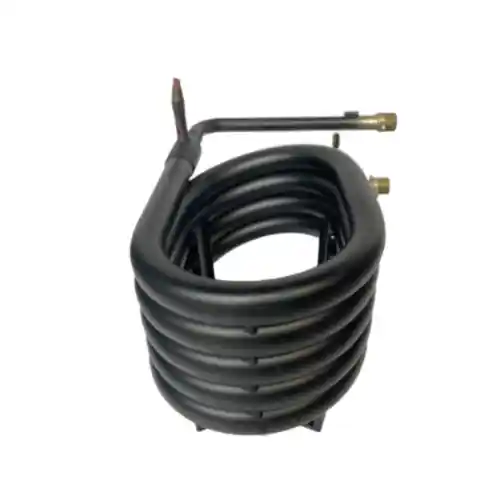1. Introduction
Stainless steel-aluminum composite tubes have emerged as a promising solution for enhancing the performance of coaxial heat exchangers. This article delves into the characteristics of stainless steel-aluminum composite tubes, their advantages, and their impact on the efficiency of coaxial heat exchangers. We will explore the composition of composite tubes, their thermal properties, corrosion resistance, and compare them with other tube materials commonly used in heat exchangers.
2. Composition and Structure of Stainless Steel-Aluminum Composite Tubes
Stainless steel-aluminum composite tubes consist of an inner stainless steel tube and an outer aluminum tube. These tubes are bonded together to create a composite structure that harnesses the benefits of both materials. The following table provides an overview of the composition and structure of stainless steel-aluminum composite tubes:
| Composite Tube Structure | Composition |
|---|---|
| Inner Tube | Stainless Steel (e.g., AISI 316, AISI 304) |
| Outer Tube | Aluminum (Al) |
| Bonding Layer | Aluminum/Stainless Steel interface or layer |
3. Advantages of Stainless Steel-Aluminum Composite Tubes in Coaxial Heat Exchangers
3.1 Optimal Thermal Performance
The stainless steel inner tube of composite tubes exhibits excellent thermal conductivity, allowing for efficient heat transfer within the coaxial heat exchanger. The aluminum outer tube provides lightweight construction and facilitates heat dissipation, further enhancing the overall thermal performance.
3.2 Enhanced Corrosion Resistance
Stainless steel is renowned for its exceptional corrosion resistance properties, making it an ideal choice for the inner tube. The aluminum outer tube acts as a protective layer, safeguarding the stainless steel from corrosive environments. This combination significantly enhances the corrosion resistance of the composite tubes, prolonging their lifespan and ensuring reliable operation in various applications.
3.3 Weight Reduction and Durability
The utilization of aluminum in the composite structure contributes to weight reduction, enabling easier installation and reducing the overall weight of the coaxial heat exchanger. Moreover, the stainless steel inner tube imparts durability, ensuring the composite tubes can withstand high temperatures, pressure differentials, and mechanical stresses.
3.4 Compatibility with Various Fluids
Stainless steel-aluminum composite tubes are compatible with a wide range of fluids, including corrosive and high-temperature substances. The stainless steel inner tube offers excellent chemical resistance, while the aluminum outer tube provides protection against external elements, making the composite tubes versatile for diverse industrial applications.
4. Comparison with Other Tube Materials
4.1 Stainless Steel Tubes
Stainless steel-aluminum composite tubes offer advantages over solid stainless steel tubes in terms of weight reduction and cost-effectiveness. The following table provides a comparison between stainless steel and stainless steel-aluminum composite tubes:
| Material | Corrosion Resistance | Strength | Thermal Conductivity (W/m·K) | Weight (g/cm³) |
|---|---|---|---|---|
| Acero inoxidable | Excellent | High | 16.3 – 24.9 | 7.7 – 8.0 |
| Stainless Steel-Aluminum Composite Tubes | Excellent | Moderate-High | Comparable to stainless steel | Lighter |
4.2 Aluminum Tubes
Stainless steel-aluminum composite tubes offer superior corrosion resistance and durability compared to solid aluminum tubes. The table below presents a comparison between aluminum and stainless steel-aluminum composite tubes:
| Material | Corrosion Resistance | Strength | Thermal Conductivity (W/m·K) | Weight (g/cm³) |
|---|---|---|---|---|
| Aluminum | Moderate | Low | 167 – 237 | 2.70 |
| Stainless Steel-Aluminum Composite Tubes | Excellent | Moderate | Comparable to aluminum | Lighter |
5. Applications of Stainless Steel-Aluminum Composite Tubes in Coaxial Heat Exchangers
Stainless steel-aluminum composite tubes find widespread applications in various industries, leveraging their unique characteristics for optimal performance in coaxial heat exchangers. Some notable applications include:
5.1 Automotive Industry
Coaxial heat exchangers utilizing stainless steel-aluminum composite tubes are extensively employed in automotive cooling systems. The enhanced corrosion resistance and thermal performance of the composite tubes contribute to efficient heat transfer and prolonged component lifespan.
5.2 Power Generation
Stainless steel-aluminum composite tubes play a crucial role in power generation applications, particularly in condenser and heat recovery systems. Their durability, corrosion resistance, and thermal efficiency make them well-suited for demanding operating conditions in power plants.
5.3 Food and Beverage Industry
Coaxial heat exchangers with stainless steel-aluminum composite tubes are utilized in the food and beverage industry for processes such as pasteurization, sterilization, and cooling. The composite tubes ensure the integrity of food products while providing efficient heat transfer and maintaining hygienic conditions.
6. Conclusion
Stainless steel-aluminum composite tubes offer significant advantages in coaxial heat exchangers, including optimal thermal performance, enhanced corrosion resistance, weight reduction, and compatibility with various fluids. The combination of stainless steel and aluminum in a composite structure harnesses the individual strengths of each material, resulting in an efficient and durable solution. Compared to solid stainless steel and aluminum tubes, stainless steel-aluminum composite tubes strike a balance between corrosion resistance, thermal conductivity, and weight reduction. These composite tubes find diverse applications in the automotive industry, power generation, and the food and beverage industry. By incorporating stainless steel-aluminum composite tubes, engineers and designers can optimize the performance and efficiency of coaxial heat exchangers in a wide range of industrial sectors.


